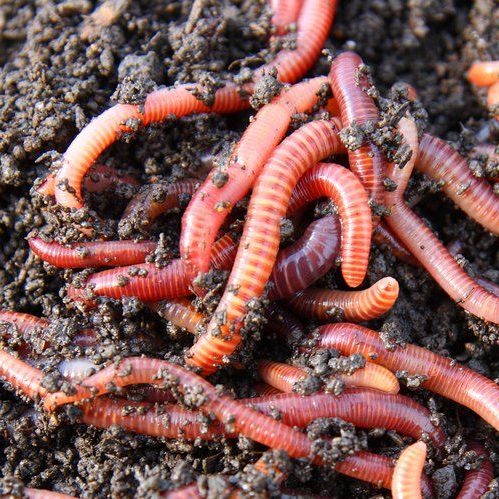Lake Hickory Bait: Providing Reliable Bait for Anglers Everywhere
Lake Hickory Bait: Providing Reliable Bait for Anglers Everywhere
Blog Article
Red Wigglers 101: Whatever You Need to Know for Thriving Gardens
Red wigglers, or Eisenia fetida, play an important duty in sustainable horticulture techniques, offering as reliable decomposers that transform natural waste right into valuable vermicompost. Understanding their habitat, dietary preferences, and the myriad benefits they supply can change your horticulture approach.
Comprehending Red Wigglers

Red wigglers thrive in environments abundant in natural material and wetness. Red Wiggler Express. They have an unique digestive system that permits them to process food scraps rapidly, excreting castings that are loaded with necessary nutrients such as nitrogen, phosphorus, and potassium. These castings improve soil framework, improve water retention, and foster valuable microbial activity, every one of which add to durable plant wellness
Additionally, red wigglers can endure in varied problems, making them adaptable to different gardening methods, consisting of interior and outdoor composting systems. Their capability to consume huge amounts of natural waste daily settings them as beneficial allies for both home gardeners and industrial growers. By incorporating red wigglers right into horticulture efforts, one can dramatically boost dirt fertility and assistance sustainable gardening practices.
Perfect Habitat for Red Wigglers
Creating an optimal environment for red wigglers is essential for maximizing their composting abilities and overall health. Red wigglers grow in damp, dark, and well-aerated habitats, which very closely resemble their native environments in ground cover and decomposing natural matter. A suitable habitat must provide a temperature variety in between 55 ° F and 77 ° F(13 ° C to 25 ° C), as severe temperatures can emphasize or damage the worms.
The bed linens material, such as shredded paper, cardboard, or coconut coir, ought to be maintained wet however not overly wet, as too much moisture can bring about anaerobic problems harmful to worm wellness. Furthermore, a pH degree between 6.0 and 7.5 is ideal, guaranteeing a balanced setting.
Appropriate aeration is just as crucial; it enables oxygen blood circulation and avoids the build-up of damaging gases. A container or container developed for vermicomposting ought to have drainage openings to get rid of excess wetness and advertise air flow. Normal tracking of these conditions is important for maintaining a growing red wiggler populace, eventually boosting their efficiency in damaging down organic waste and enriching garden dirt.
Dietary Needs and Preferences

Red wigglers display specific preferences; they are specifically keen on softer, decaying materials over tougher or even more coarse compounds. It is vital to prevent feeding them citrus peels, onion, and garlic in large quantities, as these can be unsafe. Furthermore, meat, dairy, and oily foods should be left out, as they can bring in pests and develop undesirable smells.
(Red Wiggler Express)To maintain ideal wellness, a well balanced mix of environment-friendly and brown products is recommended. Eco-friendly products, such as veggie scraps, supply nitrogen, while brown products, like cardboard and dried out fallen leaves, supply carbon. Keeping track of the wetness content and ensuring a consistent food supply will further enhance their growth and composting abilities. By dealing with their nutritional demands, gardeners can promote a flourishing populace of red wigglers in their garden compost systems.
Advantages of Utilizing Red Wigglers
The exceptional advantages of utilizing red wigglers in gardening extend far beyond their function in composting. These versatile microorganisms contribute considerably to soil health and wellness, improving nutrition accessibility and advertising microbial task. By aerating the dirt as they tunnel, red wigglers improve drain and origin infiltration, producing an optimum setting for plant growth.
Furthermore, red wigglers are effective recyclers of organic waste, transforming it right into nutrient-rich spreadings that work as an excellent all-natural plant food. These spreadings include beneficial microbes and crucial nutrients, such as nitrogen, phosphorus, and potassium, which are vital for plant growth. The sluggish release of nutrients from worm castings makes certain a stable supply, minimizing the danger of nutrient leaching and promoting sustainable gardening practices.
Making use of red wigglers fosters an extra sustainable horticulture method by reducing reliance on chemical plant foods and advertising a closed-loop system, where waste is changed right into valuable resources. Generally, including red wigglers into horticulture practices uses find more information a wide variety of eco-friendly and agricultural advantages.
(Red Wiggler Express)
Composting With Red Wigglers

To start an effective vermicomposting system, select a suitable container with appropriate air flow and water drainage. The ideal environment for red wigglers consists of a damp, dark setup with temperature levels between 55 ° F and 77 ° F. Begin by layering shredded paper, cardboard, and food scraps, making certain a well balanced mix of carbon and nitrogen-rich materials.
Red wigglers prosper on veggie peels, fruit scraps, coffee premises, and eggshells, while staying clear of meat, milk, and oily foods that can attract parasites. Consistently monitor wetness levels; the bed linens needs to perspire however not soaked. Harvest worm castings every couple of months by separating the worms from the compost, which can then be made use of directly in gardens or kept for later use.
Carrying out vermicomposting not only lowers landfill waste but additionally enriches garden dirt, advertising healthy plant growth and lasting horticulture practices. Embrace this environmentally friendly method to enhance your horticulture ventures.
Final Thought
In recap, red wigglers are important microorganisms for improving yard efficiency via effective composting. By making use of red wigglers, gardeners can significantly enhance dirt high quality and nutrient availability, promoting healthier plant development.
Report this page